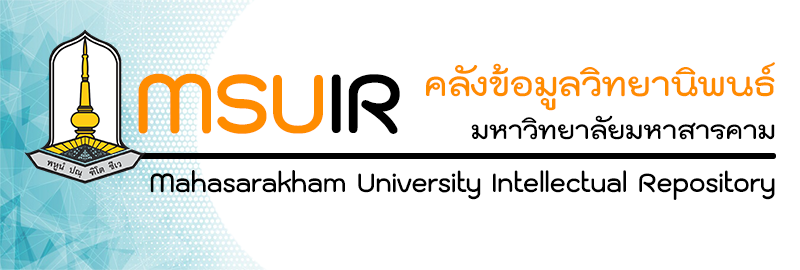Please use this identifier to cite or link to this item:
http://202.28.34.124/dspace/handle123456789/2677| Title: | The effect of polyethylene glycol on the crystal formation of polylactide stereocomplex ผลของพอลิเอทิลีนไกลคอลต่อการเกิดผลึกของพอลิแลคไทด์สเตอริโอคอมเพล็กซ์ |
| Authors: | Panthima Phuangthong พรรณธิมา พวงทอง Yottha Srithep ยศฐา ศรีเทพ Mahasarakham University Yottha Srithep ยศฐา ศรีเทพ yottha.s@msu.ac.th yottha.s@msu.ac.th |
| Keywords: | พอลิแลคไทด์สเตอริโอคอมเพล็กซ์ พอลิเอทิลีนไกลคอล การตกผลึก polylactide stereocomplex polyethylene glycol crystallization thermal conditions non-isotermal differential scanning calorimetry |
| Issue Date: | 17 |
| Publisher: | Mahasarakham University |
| Abstract: | The formation of polylactide stereocomplex (sc-PLA), achieved by blending poly(L-lactide) (PLLA) and poly(D-lactide) (PDLA), improves the material properties of PLA by enhancing strength and heat resistance. This study examined the competitive crystallization behavior of homocrystals (HCs) and stereocomplex crystals (SCs) in a 50/50 PLLA/PDLA blend with the addition of polyethylene glycol (PEG). The PEG used in this study had molecular weights of 400 g/mol and 35,000 g/mol, incorporated at concentrations ranging from 5% to 20% by weight. The findings from differential scanning calorimetry (DSC) analysis showed that PEG increased the crystallization temperature, promoted the formation of SCs, and inhibited the formation of HCs. Additionally, PEG acted as a plasticizer, reducing both the melting and crystallization temperatures. The second heating DSC curve indicated that the pure PLLA/PDLA blend had a 57.1% fraction of SCs, while the addition of 5% PEG with a molecular weight of 400 g/mol resulted in complete SC formation. Conversely, PEG with a molecular weight of 35,000 g/mol was less effective, allowing some HC formation. Moreover, PEG consistently promoted SC formation across various cooling rates (2, 5, 10, and 20 °C/min), demonstrating a strong influence under different thermal conditions. การสร้างพอลิแลคไทด์สเตอริโอคอมเพล็กซ์ (sc-PLA) ที่ได้จากการผสมระหว่างพอลิ(แอลแลคไทด์ )(PLLA) และพอลิ(ดีแลคไทด์) (PDLA) สามารถปรับปรุงคุณสมบัติของวัสดุ PLA โดยเพิ่มความแข็งแรงและทนความร้อนได้ดีขึ้น การศึกษานี้ได้ทำการตรวจสอบพฤติกรรมการตกผลึกแบบแข่งขันระหว่างโฮโมคริสตัล (HCs) และสเตอริโอคอมเพล็กซ์คริสตัล (SCs) ในส่วนผสมของ PLLA/PDLA ในอัตราส่วน 50/50 โดยมีการเติมพอลิเอทิลีนไกลคอล (PEG) ที่มีน้ำหนักโมเลกุล 400 g/mol และ 35,000 g/mol ในความเข้มข้นตั้งแต่ 5% ถึง 20% โดยน้ำหนัก การวิเคราะห์โดยใช้เทคนิคการวิเคราะห์ความร้อนเชิงอนุพันธ์ (DSC) พบว่า PEG ทำให้อุณหภูมิการตกผลึกเพิ่มขึ้น ช่วยส่งเสริมการเกิด SCs และยับยั้งการเกิด HCs นอกจากนี้ PEG ยังทำหน้าที่เป็นพลาสติกไซเซอร์ ลดทั้งอุณหภูมิการหลอมเหลวและการตกผลึก ผลการวิเคราะห์จากกราฟ DSC ในรอบการให้ความร้อนครั้งที่สอง แสดงให้เห็นว่าส่วนผสมของ PLLA/PDLA บริสุทธิ์มีส่วนของ SCs อยู่ที่ 57.1% ในขณะที่การเติม PEG 5% ที่มีน้ำหนักโมเลกุล 400 g/mol ส่งผลให้เกิด SCs สมบูรณ์ ในขณะที่ PEG ที่มีน้ำหนักโมเลกุล 35,000 g/mol มีประสิทธิภาพน้อยกว่า ทำให้ยังคงมีการเกิด HCs บางส่วน นอกจากนี้ PEG ยังส่งเสริมการเกิด SCs อย่างต่อเนื่องในอัตราการเย็นตัวต่าง ๆ (2, 5, 10, และ 20 °C/นาที) ซึ่งแสดงถึงผลกระทบที่มีอิทธิพลภายใต้เงื่อนไขที่แตกต่างกัน |
| URI: | http://202.28.34.124/dspace/handle123456789/2677 |
| Appears in Collections: | The Faculty of Engineering |
Files in This Item:
| File | Description | Size | Format | |
|---|---|---|---|---|
| 65010351503.pdf | 2.58 MB | Adobe PDF | View/Open |
Items in DSpace are protected by copyright, with all rights reserved, unless otherwise indicated.

